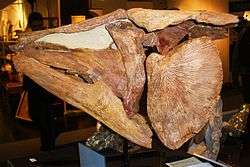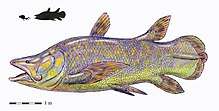''Mawsonia'' (fish)
| Mawsonia | |
|---|---|
 | |
| Skull of Mawsonia | |
| Scientific classification | |
| Kingdom: | Animalia |
| Phylum: | Chordata |
| Class: | Sarcopterygii |
| Order: | Coelacanthiformes |
| Family: | †Mawsoniidae |
| Genus: | †Mawsonia Woodward, 1907 |
| Species | |
| |
Mawsonia is an extinct genus of prehistoric coelacanth fish, and the largest of this group, up to several meters long.[1] It lived during the Cretaceous period (Albian and Cenomanian stages, about 99 to 112 million years ago). Fossils have been found in the Tegana and Aoufous Formations of Morocco, the Continental Intercalaire Formation of Algeria and Tunisia and the Ain el Guettar Formation of Tunisia, Africa, the Babouri Figuil Basin of Cameroon and the Bahia Group and Alcântara and Missão Velha Formations of Brazil, South America. Mawsonia was first described by British palaeontologist Arthur Smith Woodward in 1907.[2]

Reconstruction of Mawsonia
References
Further reading
- Fishes of the World by Joseph S. Nelson
- History of the Coelacanth Fishes by Peter Forey
- Discovering Fossil Fishes by John Maisey and John G. Maisey
- The Rise of Fishes: 500 Million Years of Evolution by John A. Long
- Evolution of Fossil Ecosystems by Paul Selden and John Nudds
This article is issued from
Wikipedia.
The text is licensed under Creative Commons - Attribution - Sharealike.
Additional terms may apply for the media files.